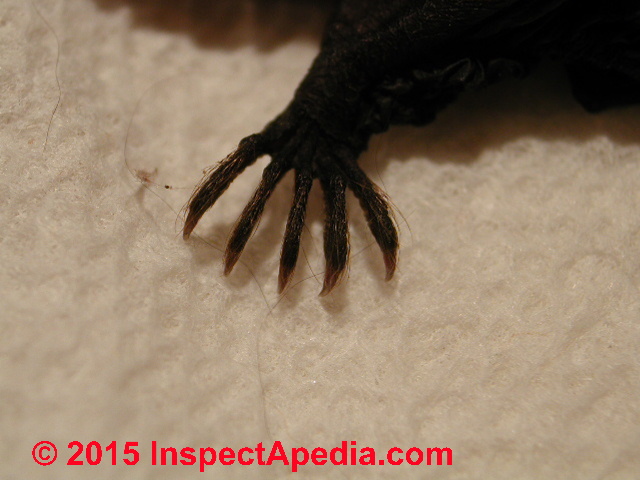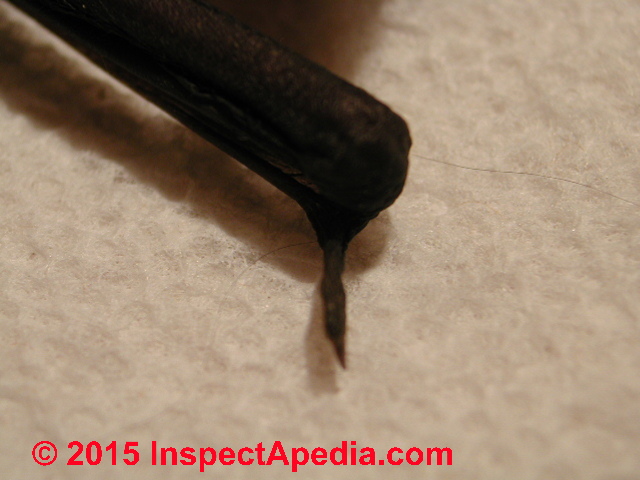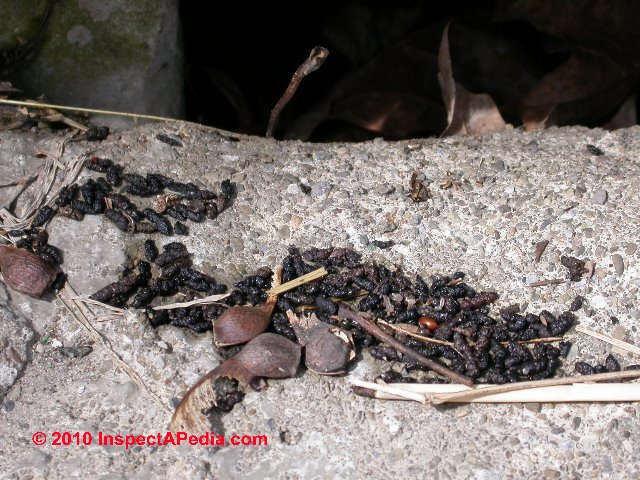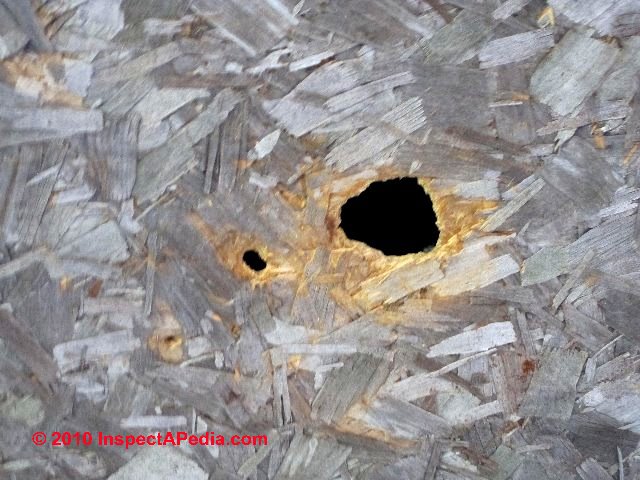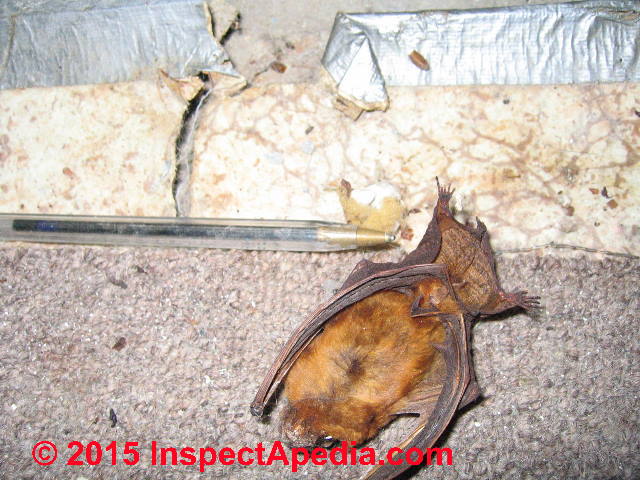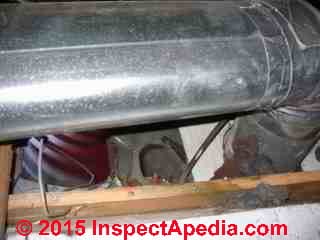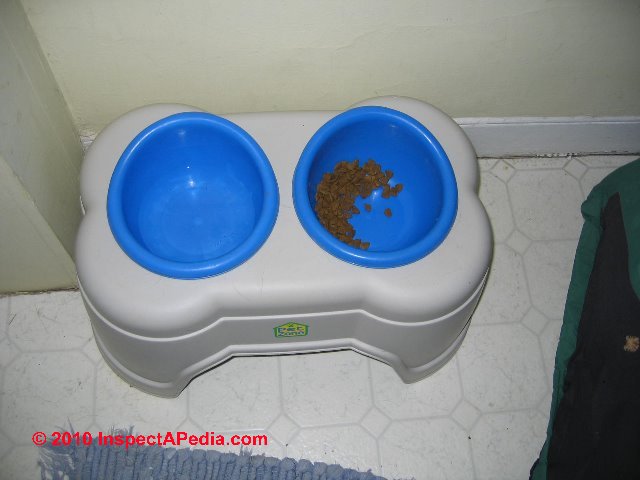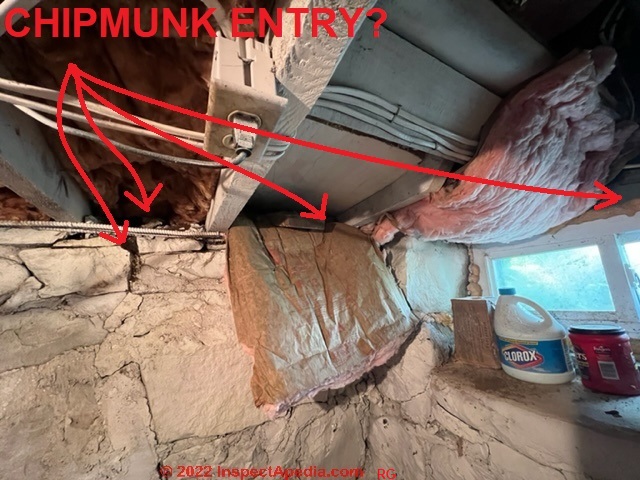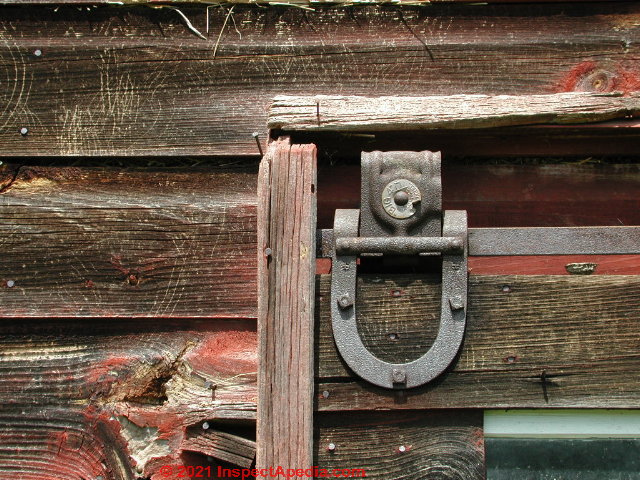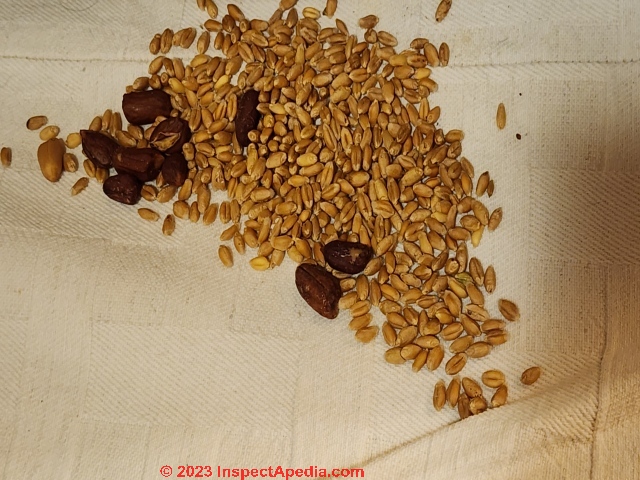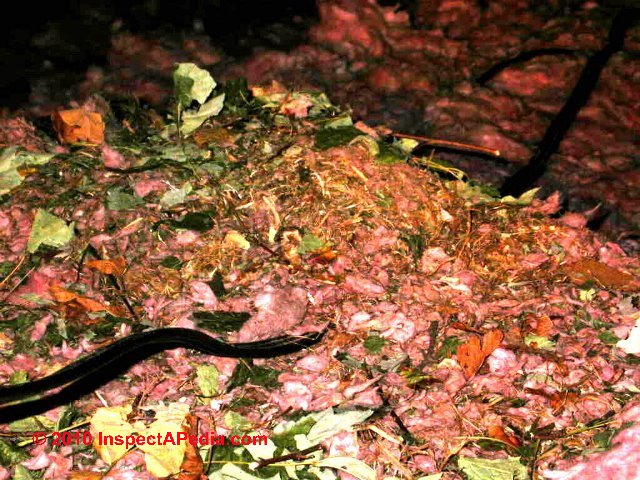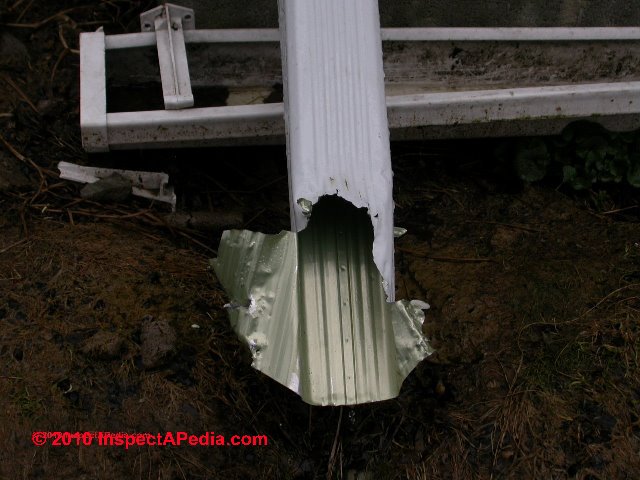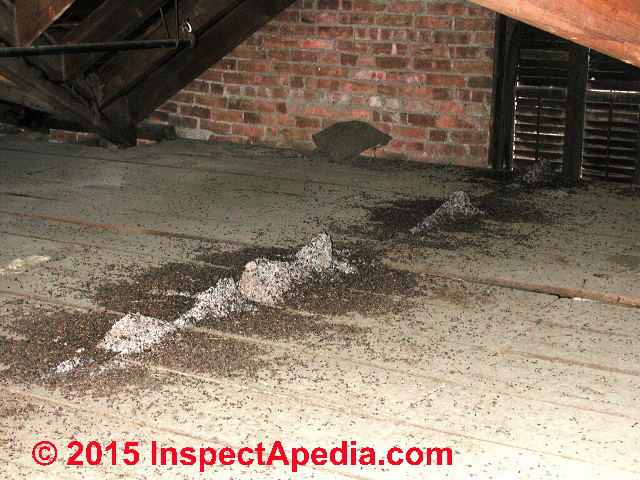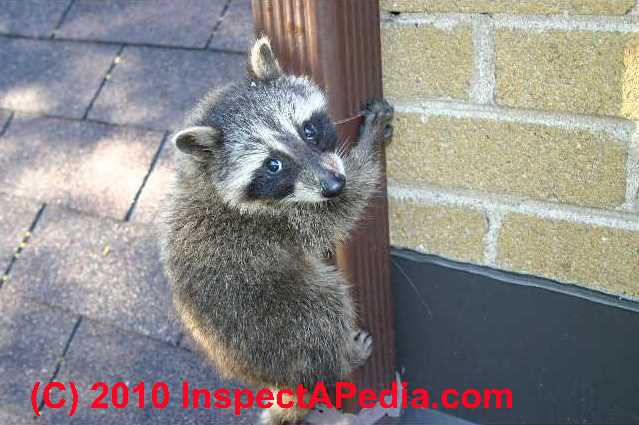 Keep Bats, Birds, Mice, Rats, Squirrels, Raccoons Out of Your Building
Keep Bats, Birds, Mice, Rats, Squirrels, Raccoons Out of Your Building
Health hazards, & solultions
for un-wanted pests & their droppings
- POST a QUESTION or COMMENT about how to keep animal pests out of buildings
Animal entry points in buildings:
This article series discusses how to find where animals are getting into your building and how to keep them out, including bats, birds, rats, mice, and squirrels and even raccoons.
This article series focuses on removing pet or other animal odors from buildings due to pet urine, pet feces, wild animal urine, or even human urine on and around buildings or on clothing and other soft materials.
InspectAPedia tolerates no conflicts of interest. We have no relationship with advertisers, products, or services discussed at this website.
- Daniel Friedman, Publisher/Editor/Author - See WHO ARE WE?
Find Animal Entry Points in Buildings
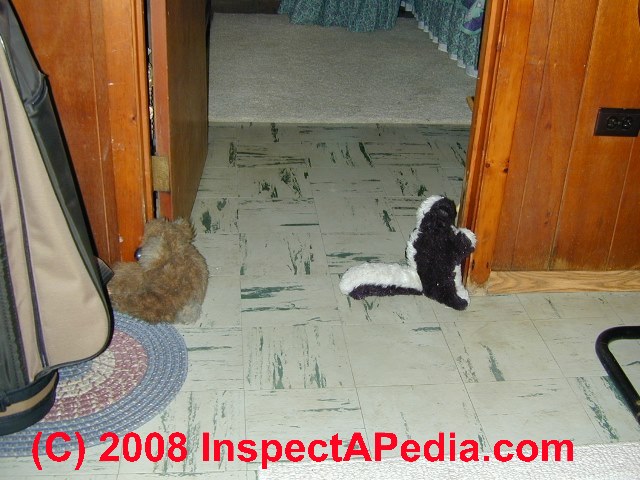 Article Contents
Article Contents
- ANIMAL BITES & SCRATCHES - BATS
- ANIMAL ENTRY POINTS - WHERE THEY GET IN
- KEEPING ANIMALS OUT of BUILDINGS
- BIRDS in the ATTIC?
- CHIPMUNKS in the BASEMENT?
- RACCOONS in the HOUSE?
- SQUIRRELS in the HOUSE
- FIND & REMOVE DEAD ANIMALS INDOORS
- FIND & REMOVE ANIMAL FECES & URINE
- REPELLENTS for ANIMAL PESTS
Photo above: the little stuffed animals in this photo include a skunk - both were innocent of any pet crimes, but they had been placed at either side of a basement door jamb to cover stains from basement water entry.
Watch out: in addition to their common role as allergens, animal feces, urine, even hair can offer serious health hazards including from various pathogens: bacteria, viruses, even possibly rabies.
Watch out: also for wild animal bites, bacterial and viral hazards when entering confined spaces where invaders are or have been present.
The author (DF) became temporarily ill after (foolishly) working in a "clean looking" crawl space that later he realized had a heavy contamination of fecal and urine contaminated mouse dust. Bat and rodent droppings as well as bird droppings can be a source of a pathogen potentially dangerous to humans, the fungus Histoplasma capsulatum.
Watch out: before sealing up a hole in a soffit or wall where squirrels or bats are entering your building, make sure the animals are not going to be trapped inside where they will be mad, frightened, hostile, even dangerous (like a rabid raccoon), or ultimately dead and another source of stink.
What to do if a Bat Gets in Your Home.
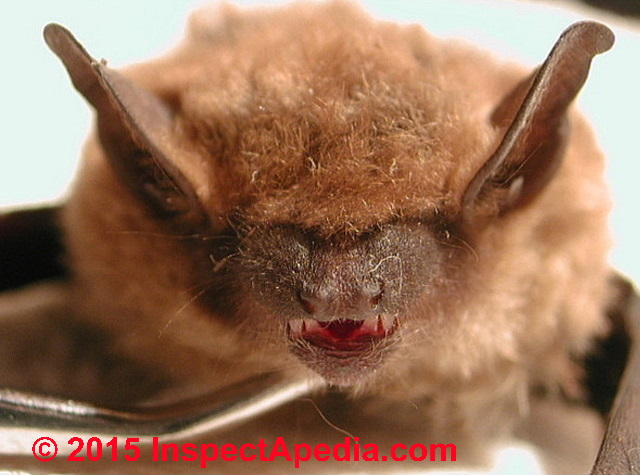 What Percentage of Bats Carry Rabies?
What Percentage of Bats Carry Rabies?
The brown bat shown at left was captured in a Poughkeepsie, New York home when an agile family cat nabbed the bat mid-swoop.
Watch out: do not handle (touch directly) sick or dead bats or other rodents.
The owners worried that the cat was going to need rabies shots.
According to the U.S. CDC, only about six percent of bats captured and tested had rabies.
If you consider that it's the weaker old bats or sicker bats of any age who are more likely to be captured, that suggests that in the total brown bat population, the percentage suffering from rabies is probably considerably less than six percent.
After posing this bat for a few photos, we delivered the brown bat shown at left to the county health department whose tests showed that it may have been elderly or ill but it did not have rabies. The U.S. CDC advises:
Whenever possible, the bat should be captured and sent to a laboratory for rabies testing. People can't get rabies just from seeing a bat in an attic, in a cave, at summer camp, or from a distance while it is flying.
In addition, people can't get rabies from having contact with bat guano (feces), blood, or urine, or from touching a bat on its fur. If you think your pet has been bitten by a bat, contact a veterinarian or your health department for assistance immediately and have the bat tested for rabies.
Remember to keep vaccinations current for cats, dogs, and other animals. - U.S. CDC, "Learning about bats and rabies", retrieved 3 June 2015, original source http://www.cdc.gov/rabies/bats/education/
If you capture a bat or encounter a dead one, do not handle it. If you capture a bat, have it tested for rabies if people or pets have been exposed to it.
If no one has been exposed or is likely to be exposed to the animal, testing may not be necessary: check with your local department of health.
Local health departments do not always advise testing animals for rabies. When a rabid skunk tottered around in our neighborhood and was found dead the next day, the New York Dutchess County health department advised not to touch it but that they were not interested in testing it for rabies unless we thought that someone may have come in contact with it.
What to Do if You are Bitten or Scratched by a Bat or if You Think You Were?
If you are bitten by a bat you probably will know it, but as you can see in our bat photograph above the little brown bat's teeth are tiny. A bite mark may disappear quickly as may scratch marks from their little bat toes or bat wingtip claws - shown in our two photographs just below.
Watch out: If you are bitten or scratched by an unfamiliar animal, wild or domestic, wash the wound thoroughly with soap and water and seek medical attention right away.
Here is the US CDC advice for what to do if you are not sure if you have been bitten or scratched by a bat:
If you woke up because a bat landed on you while you were sleeping or if you awakened and found a bat in your room, you should try to safely capture the bat and have it tested.
The same precautions should be used if you see a bat in a room with an unattended child, or see a bat near a mentally impaired or intoxicated person.
The small teeth of the bat can make a bite difficult to find. Be safe and in these situations, try to safely capture the bat, have the bat tested, and seek medical advice. - U.S. CDC, "Learning about bats and rabies", retrieved 3 June 2015, original source http://www.cdc.gov/rabies/bats/education/
Common Spots for Animal Entry in Buildings: Bats, Birds, Rodents, Snakes

-
Look outside, too, for Bats, Birds, Rodent Entry Points
if your building has been invaded by bats, rats, mice, squirrels, or other wild animals, you should inspect both indoors and outside for openings or stains and marks that indicate points of entry and exit for those creatures.
Consult with a pest control professional who may have a practiced eye at spotting where animals are getting into your attic, roof, walls, basement, and who may be able to provide a repellant that will at least temporarily drive them out - alive.
While there are no bat control poisons currently approved in the U.S., we have found that moth balls (naphtha) are an effective repellent for bats and squirrels, though naphtha odors are also repellent to some humans.
As we explained above, when the bats or other invaders are out of your building, that's the time to seal the openings through which they enter.
And a small number of bats (less than 1% of bats are rabid according to the U.S. CDC) and unfortunately, in some areas of the U.S., a larger number of raccoons may be carrying rabies. If you see an animal acting oddly, stumbling, or apparently unafraid of humans and very aggressive, stay away and don't get bitten.
At BUILDING SAFETY HAZARDS GUIDE we discuss handling hazards from pets or other animals that may bite a building inspector.
Bats in the Building?
Our photos below, (courtesy of Paul Galow), show how easy it may be to spot an outdoor point where bats were entering a building: bat droppings were noted on the ground, and stains are noted at the top of the wall just over that point. -
A good time to seal building openings against bats
is late fall when the young have matured and leave their roosts each evening - just make sure they are not at home before you seal a building entry point.
Or try installing a "one-way" flap over the opening that will let the bats out but not back in. Leave that in place for a few days or a week, then close it permanently. The best time to seal building openings against bats is after late fall or during winter when bats will have left the building to hibernate.
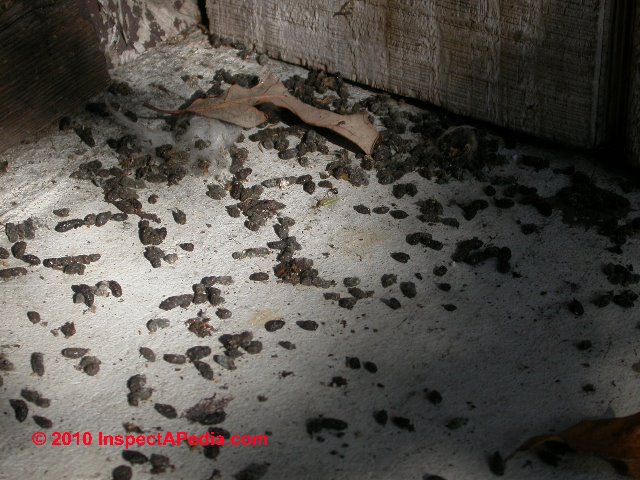
Watch out: do not kill bats unnecessarily.
Bats are already in trouble in many areas of the world, including some of the 45 species found in the U.S. And we need them.
Bats eat large numbers of night-flying insect pests (such as mosquitoes) and are an important part of our environment.
Avoid closing bat roosting openings in buildings between May and August (in the northern hemisphere) because you may trap young bats in the building.
Young bats that have not yet become able to fly won't escape and will die in the building.
For more information about bats, contact Bat Conservation International at www.batcon.org
Above & below are more bat-invasion photographs.
You will see that the cupped metal roofing formed a nice opening for bats to enter this home, and again, a telltale collection of bat guano droppings below this very spot. Birds and squirrels also enter buildings at openings like this, as we discuss just below.
Watch out: Histoplasmosis (from bat
droppings) is an infection
caused by inhalation of Histoplasma capsulatum. In people with compromised
immune system, this can be a particularly dangerous infection, potentially fatal if not treated. See also granuloma, iritis, lung nodules. More information is
Birds in the Attic?
- Birds in the Roof Structure or attic
may be entering through a hole they managed to peck in a roof overhang or soffit such as shown in our photo below (courtesy of Paul Galow).
- Birds in the Attic at infestation levels
may be obvious if you spot bird dropping stains such as those shown on our photo (below).
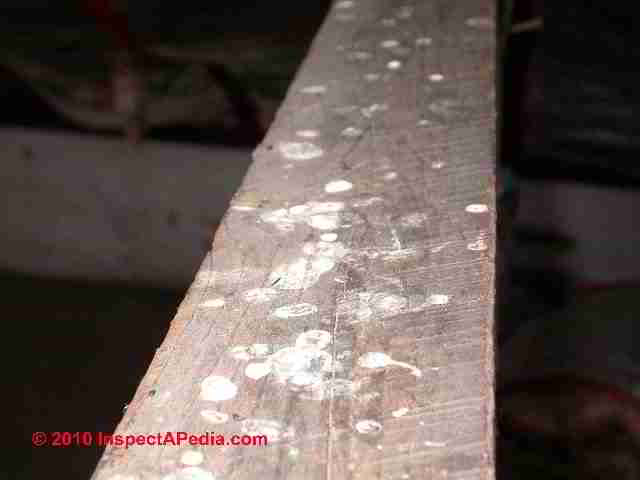
Watch out: Cryptococcus infection (cryptococcosis): (from bird droppings), at primary risk are people with compromised immune system but normal adults can also be infected by inhalation of Cryptococcus neoformans, leading to a form of meningial encephalitis.
Cryptococcosis is a fungal disease caused by Cryptococcus neoformans or Cryptococcus gattii.
Most people do not get sick with cryptococcosis, but some people are more likely than others to get this disease. For these people, cryptococcosis can cause serious symptoms of lung, brain and spinal cord disease, such as headaches, fever, cough, shortness of breath, and night sweats.
Cryptococcus neoformans is found in bird droppings. More information is
Find & Remove Dead Animal Pests Indoors
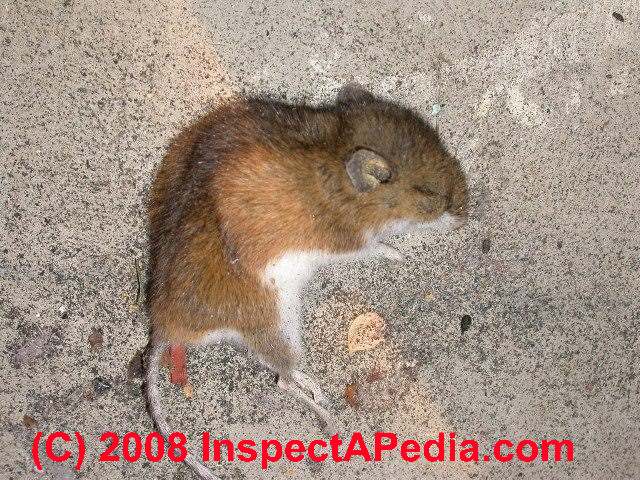
- Also check for dead animals
in building attics, crawl spaces, wall or ceiling cavities and in duct work or air handlers or chimneys. The dead mouse (above left) fell out of a suspended ceiling on to the living room carpet.
The dead bat (below) was found in the suspended ceiling of a Kingston New York public building.Animal odors in buildings can occur when an animal such as a mouse or rat has died in a building cavity.
A dead animal smell has been described by our clients with a wide variety of terms ranging from a vague noxious stink that seemed to vary with humidity to a sweet sickly smell.
Watch out: do not handle dead animals directly as there could be hazards of rabies, bacteria or viruses.
- Dead animals or even insect nests
in building plumbing,
especially building vents, can also produce unexpected sewer odors - see Septic and Sewer gas odor links discussed below. - Rodents,
especially in the HVAC system such as air ducts, may also be a bacterial or Hanta virus hazard.
Below, using a photo from a Poughkeepsie NY Home, we illustrate a time-proven expedient method for closing off small openings through which mice enter a home.
An over-sized hole cut for water supply piping below the kitchen sink was an open door for mice. Jamming some steel wool into the opening is ugly but effective.
How to Keep Bats, Rats, Mice, Raccoons or Squirrels out of Your Home
Our photo above shows a skunk rummaging on a golf course. If you see a skunk meandering in daylight stay well away - stay away any time for that matter. This skunk was found dead two days after its photo was taken, probably due to rabies.
Above, you see use of steel wool used to plug rodent entry points in a building. Pest control experts recommend several simple steps that will discourage mice and squirrels from moving into your building as they are inclined to do particularly at the beginning of cold weather:
- Housekeeping:
clean up spilled food, seal food in rodent-proof containers - Garbage:
garbage and trash cans should be made of metal and kept closed; clean up any spilled garbage around your trash cans, both indoors and outside.
Watch out: be sure your garbage can lids fit securely - raccoons are very good at opening them up to explore. And never corner a racoon indoors - you will be sorrier than the raccoon will be when you're bitten. (Not to mention the occasional rabies worry).
- Pet food:
we found that storing open bags of cat or dog food invited mice into the same area, a problem solved by keeping those large pet food bags in a small metal covered garbage can.
We also stopped leaving pet food in bowls overnight.
Above are bats on the outside of the screened attic gable vent opening of a U.S. home. These bats were not able to enter the home but heaven knows the effect on the bats if the burglar arm speaker (at left in the photo) sounds.
Loudspeakers are not likely to be an effective bat or rodent deterrent.
- Seal building openings:
as we discussed above about bats, look outside for openings into the building such as at soffits or roof eaves, especially near overhanging or close tree branches (squirrel highways), and close to the ground, look for openings into the basement at vents, windows, or building sill plates and siding bottom edges.
Seal these when you won't be trapping animals inside. We have read that mice can enter a building through openings as small as 3/8"!
Trim shrubs at least a foot away
from the building walls; we prefer 18".
This also reduces the attractiveness of the building to insect pests such as termites and carpenter ants.
If your home is in an area where Norway rats are a problem, keep low growing shrubs away from your building walls entirely as those rats burrow under them, especially Junipers and Taxus.
Readers should also see
ANIMAL or URINE ODOR SOURCE DETECTION followed
by ANIMAL or URINE ODOR REMOVAL.
If your building odor complaint source is found to be outdoors,
see URINE ODOR REMOVAL at BUILDING EXTERIOR.
Also see URINE ODOR REMOVAL in CLOTHING - this article describes bacterial/enzyme based cleaners that may be extra effective in removing human or animal urine odors from clothing, diapers, bedding, towels, etc.
Chipmunk Control in Buildings
 How can we keep chipmunks from pushing dirt into our basement?
How can we keep chipmunks from pushing dirt into our basement?
An InspectApedia reader asked:
We've been having an annoying chipmunk problem at our home. The chipmunks burrow through the stone foundation wall and they keep pushing dirt into the basement.
We don't want to kill them and besides we think the number of chipmunks is effectively infinite.
We don't want to accept your suggestion to use mothballs as a repellent because we don't like them.
So what can we do? - Anonymous by private email & telephone 2022/07/02 [discussion paraphrased by moderator]
Moderator reply:
We established by conversation that yours is an older home, built in upstate New York, before 1900, in a wooded area.
You also added that you think the chipmunks are burrowing below a concrete patio that is poured up against the foundation wall, preventing any outdoor measures in that area.
Watch out: chipmunks and squirrels can carry plague. See details at our REFERENCES section.
Watch out: as an important side point, we warned that a concrete slab against a foundation wall, particularly if there is not good ground clearance to any wood materials atop the foundation, invites wood destroying insects, rot, and animal pests.
At the very least you want the patio to slope away from the structure. Measures to try to waterproof the juncture of an in-slope concrete patio and a foundation wall are not likely to be effective in the longer term.
So what's left when we don't want to trap and relocate, don't want to kill, and don't want to repel annoying rodents?
1. Reduce the attractiveness of the building to chipmunks.
As you'll read in some of our recommended research articles on rodent control, such as
Snodgrass, Kathleen, CONTROLLING RODENTS IN FOREST SERVICE FACILITIES [PDF]
Choice of plantings near the building can help as can keeping rodent-protecting shrubs away from the structure at least two feet. I know you describe a patio against the foundation wall, but if there are plantings at the sides of that patio be sure they're away from the structure.
For a more technical exposition at our RESEARCH list, see the live link at our citation of Wilk, Randall J.; Harrington, Timothy B.; Gitzen, Robert A.; Maguire, Chris C. 2015. Forest floor disturbance reduces chipmunk ( Tamias spp.) abundance two years after variable-retention harvest of Pacific Northwestern forests . Northwest Science. 89(1): 75-92.
Wilk and Harrington found that chipmunk populations declined up to 70 percent with decreasing level of overstory trees and increasing disturbance of the forest floor from forest harvesting.
2. Make it more difficult for the chipmunks to enter the building.
For the case described above that means
- Remove insulation:
from the rim joist in the basement, to expose the area for close inspection - Dispose of any insulation:
that may have been infested by any rodents as there could be serious health hazards (again cited in our RESEARCH list) - Close openings:
for an old stone foundation, especially if dry-laid without mortar, there will be many openings that need to be sealed with mortar.
Along the rim joist, and providing your inspection doesn't find insect damage or rot that need treatment or repair, where there are openings admitting chipmunks, nail up hardware cloth (1/4" square galvanized iron mesh).
3. Repel the chipmunks
- See other options (as you object to mothballs)
at REPELLENTS for ANIMAL PESTS - Ultrasonic chipmunk repellant device?
The USFS Snodgrass article suggests that electronic devices that repel rodents have promise.
Really? We have found those devices stunningly ineffective and I [DJF] have personally seen a mouse walk right up to, sniff, and investigate a large commercial ultrasonic mouse and rodent repelling device!
See details at MOUSE in the HOUSE GET RID of ANIMAL PESTS
Mouse - Mice Problems Indoors
Mouse-specific tips on how to get rid of mice in your home and how to keep them out are
at MOUSE in the HOUSE - separate article
Raccoons Like it Indoors in Buildings
To give the raccoons more space, we move them to RACCOONS in the ATTIC, a separate article that relates a true story about raccoons invading a New York home at Christmas. A brief excerpt is just below.
Dan and Laura were snuggled up reading in bed on a cold Poughkeepsie January night. Suddenly overhead they heard
SMACK! rattle, rattle, rattle, rattle, rattle, rattle, roll. Something or someone was in the attic! Now they heard the sound of little clawed feet scampering across the attic floor just over their heads.
The home, built in 1900, was a neo-Victorian with a large walk-up attic wherein were stored the usual detritus: old rugs, suitcases, trunks, broken lamps, bicycle parts, and other who-knows-what. Some animal, maybe more than one of them, was smashing something around in the attic. What the hey?
Dan tiptoes over to the door at the bottom of the attic stairs in his pajamas. He leans an ear against the cold red-varnished wood. Cold air leaks out of the attic and rolls across his bare toes adding to the chill of the sounds of intruders above...
Also see POETRY & SHORT FICTION, Daniel Friedman
Signs of Raccoons Outdoors
In the photo below, by their size and location, these are probably raccoon scratches on the exterior siding of a barn (D Friedman 2001, Catskills NY) .
Squirrels and mice also gnaw and scratch at buildings and building components but the scale of those marks is usually notably smaller.
Are There Squirrels in the House?
Below: at this home in San Miguel de Allende in Guanajuato, Mexico, a squirrel, an ardillo, was persistent at trying to get into the home's living room and had to be shooed out several times.
When we lifted the cushions on the living room couch (above) we saw what the ardillo (squirrel) had been up-to: caching a store of peanuts and other seeds (below).
Below, our photos show a stunning nest project built by squirrels in the attic of a 1960's home in New York.
The squirrels entered through openings in the home's aluminum soffit covering, tore up fiberglass insulation, and built the mounded nest in our photo above. Squirrel droppings on attic insulation are shown in our second photo below .
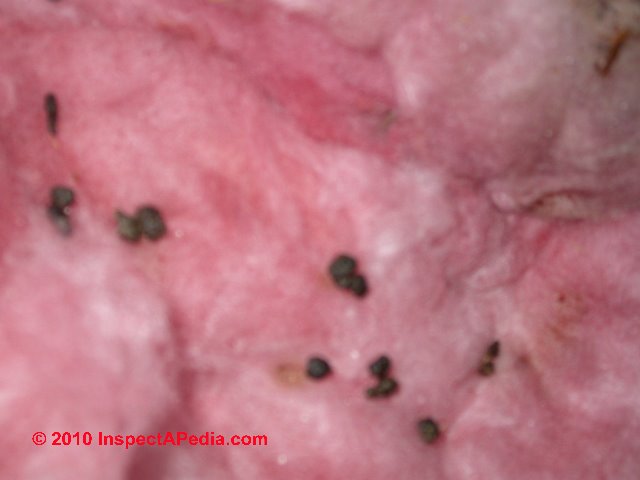
Below we show another sign of squirrel invasion of an attic: leaves brought into the attic to add to insulation as a nesting material.
One of our favorite squirrel invasion indicator photos provided by a reader is shown below.
When squirrels nest or simply hide in an aluminum downspout, the sound or smell of the squirrel can be enough to drive some dogs mad as they try to tear their way into the squirrel's hiding place (below).
Animal Feces & Urine Detection & Clean-Up
Our photo above of deep piles of bat guano in the attic of a pre-1900 church was taken during a building inspection in Staatsburgh, New York.
When you find mountains of bat droppings like this you can figure that bats have been inhabiting this building for decades.
List of Common & Effective Squirrel & Rodent Repellant or Rodent Aversive products
For rodents, which would include squirrels, some prepared products and specialty chemicals or preparations sold as repellents include:
- Andrographolide
- Aversives
- Bitterants
- Capsaicin oleoresin - found very effective even at low concentrations [9][10]
- Colocynth
- Denatonium Benzoate Bitterant (extremely bitter, used in a variety of products)
- Denatonium saccharide
- Natural and synthetic bitterants
- Nonivamide
- Trans-capsaicin
- Castor oil, habanero pepper extract and white distilled vinegar have been used as a DIY spray and also are found in some patented squirrel repellant products
Research on Animal Control & Animal or Rodent Health Hazards in & at Buildings
- AB, Cory Olson & Susan Holroyd, MANAGING BATS in BUILDINGS - Alberta Guidelines [PDF] Alberta Department of Environment, - retrieved 2022/07/17 original source: https://www.albertabats.ca/wp-content/uploads/Alberta_Bats_in_Buildings.pdf
Excerpts:
This document was originally adapted, with permission, from Got Bats? A BC Guide for Managing Bats in Buildings, which was prepared by the BC Community Bat Program (www.bcbats.ca). The BC version was written by Juliet Craig and Mike Sarell.
Alberta revisions were written and adapted by Cory Olson and Susan Holroyd, and where applicable, retained content from the original version created for BC. Layout and graphics design for the Alberta version was completed by Cory Olson.
Many people love bats and encourage them to use areas of their property where conflict can be avoided. However, in some cases, issues such as noise, smell, and guano accumulation can become major challenges for landowners.
In many of these cases, the colony has remained unattended for many years, allowing it to become established and substantial amounts of guano to accumulate—regular inspection, maintenance and cleaning could have prevented these issues.
Fortunately, bats do not chew through insulation or wiring and often regular cleaning and simple modifications can often allow bats to continue using a building with few problems for owners.
When building owners have reached the conclusion that keeping the bats is not an option, proper timing is key for planned exclusions and building repairs. In Alberta, most active colonies only occupy buildings in summer, although one species (Big Brown Bats) may use buildings for overwintering.
Waiting until bats leave the site on their own greatly reduces the risk to bats and is often the easiest, lowest cost and most effective way to exclude bats. - Adesiyun, Abiodun A., Alva Stewart-Johnson, and Nadin N. Thompson. "Isolation of enteric pathogens from bats in Trinidad." Journal of wildlife diseases 45, no. 4 (2009): 952-961.
- Anticimex®, RATS and MICE - UNWANTED GUESTS [PDF], general advice and entry points to plug, Antiximex®, Sweden, Website: www.anticimex.se retrieved 2020/01/10, original source: https://www.sssb.se/en/wp-content/uploads/sites/2/Facts_ratsmice_ENG.pdf
- BC, Juliet Craig & Mike Sarell Got Bats? 7 STEPS for MANAGING BATS in BUILDINGS [PDF] A guide for Pest Management Professionals in BC, BC Community Bat Programs, Tel: 1-855-922-2287 | email: info@bcbats.ca | web: www.bcbats.ca- retrieved 2022/07/17 original source: http://www.cwhc-rcsf.ca/docs/7_Steps_for_Managing_Bats_in_Buildings.pdf
Excerpt:
This guide provides information to help you stay safe around bats that are roosting in your buildings and help bats stay safe around people. By following these guidelines, you can help conserve bats in the NWT. - Bender, Carol H., CHIPMUNKS & SQUIRRELS CAN CARRY PLAGUE - CAUTION ADVISED [PDF] (2013) El Dorado County Health Department, El Dorado County California Environmental Management Tel: (530) 573-3450 - retrieved 2022/07/27, original source: https://www.edcgov.us/County%20Press%20Releases/Pages/chipmunks_and_squirrels_can_carry_plague_-_caution_advised.aspx
Excerpt:
Last September and October, a surveillance effort identified three chipmunks as positive for plague in the South Lake Tahoe area; two were found near the U.S. Forest Service Taylor Creek Visitor Center and one was found near the Tallac Historic Site. There were no reports of illness to people. - Brittingham, Margaret C., PhD. and Shannon T. Falker, CHIPMUNKS [PDF] PennState Extension, retrieved 2022/07/27 original source: https://extension.psu.edu/chipmunks
Excerpt:
Exclusion
Exclude chipmunks from buildings wherever possible. Use caulking, hardware cloth with quarter-inch mesh, or other appropriate materials to close openings where chipmunks could gain entry. Hardware cloth also may be used to exclude chipmunks from flower beds.
Seeds and bulbs can be covered by quarter-inch hardware cloth, and the cloth itself should be covered with soil. The cloth should extend at least 1 foot past each margin of the planting. Where high populations of chipmunks exist, exclusion often is less expensive than trapping. - CIEH, PEST CONTROL PROCEDURES IN THE HOUSING SECTOR, [PDF] (2010) Chartered Institute of Environmental Health, Website: www.cieh.org retrieved 2017/11/15, original source: http://www.cieh.org/uploadedFiles/ Core/Policy/Environmental_protection/ Pest_management/NPAP/ pest_control_procedures_in_the_ housing_sector.pdf
- Cox, Peter, Merran Griffith, Mark Angles, Daniel Deere, and Christobel Ferguson. "Concentrations of pathogens and indicators in animal feces in the Sydney watershed." Applied and Environmental Microbiology 71, no. 10 (2005): 5929-5934.
- Drexler, Jan Felix, Victor Max Corman, Florian Gloza-Rausch, Antje Seebens, Augustina Annan, Anne Ipsen, Thomas Kruppa et al. "Henipavirus RNA in African bats." PloS one 4, no. 7 (2009): e6367.
- EBPF, GUIDELINE ON BEST PRACTICE IN THE USE OF RODENTICIDE BAITS AS BIOCIDES IN THE EUROPEAN UNION, [PDF] retrieved 2017/11/15 original source: http://www.rrac.info/content/uploads/CEFIC-EBPF-RWG-Guideline-Best-Practice-for-Rodenticide-Use-FINAL-S-.pdf
Excerpt:
Watch out ..., as mentioned above, it is not recommended to clean up the site as drastic habitat changes will disturb the rodents and may cause them to be wary of the bait and, perhaps, move away to neighbouring buildings. The site may be cleaned when the rodent infestation has been eliminated. - Greer, D. L., and B. Bolaños. "Role of bats in the ecology of Paracoccidioides brasiliensis: the survival of Paracoccidioides brasiliensis in the intestinal tract of frugivorous bat, Artibeus lituratus." Medical Mycology 15, no. 3 (1977): 273-282.
- Hyngstrom, Scott E., Gary E. Larson, and Robert M. Timm, eds. PREVENTION and CONTROL of WILDLIFE DAMAGE Vol. 1. [PDF] Lincoln, USA: University of Nebraska, 1994.
Excerpt:
This handbook is a comprehensive reference of North American vertebrate species that can cause economic damage to resources or become a nuisance at various times and places.
It is intended for use by extension agents and specialists, wildlife biologists, animal control officers, public health personnel, pest control operators, teachers and students of wildlife biology, and others who deal with wildlife damage problems. - IL, HEALTH HAZARDS ASSOCIATED WITH BIRD AND BAT DROPPINGS [PDF] Illinois Department of Public Health,
535 West Jefferson Street
Springfield, Illinois 62761
Phone 217-782-4977
Fax 217-782-3987
TTY 800-547-0466 retrieved 2022/07/17, original source: http://www.idph.state.il.us/ public/hb/hbb&bdrp.htm#:~:text= Bats%20are%20associated%20with%20a, infected%20with%20the%20rabies%20virus.
Excerpt:
Bats and disease
Bats are associated with a few diseases that affect people, such as rabies and histoplasmosis. Rabies is a dangerous, fatal disease, but only about 5 percent of bats submitted for testing are infected with the rabies virus.
In recent years, there has been increased concern about the risk of rabies transmission following contact with bats. If an injured or ill bat is found in or around a structure, it should be removed.
Because most bats will try to bite when handled, they should be picked up with tongs or a shovel. (contact your local animal control officer or the Illinois Department of Natural Resources at 217- 785-8774 for information on safe bat capture.) If a bat has bitten or scratched a person or pet or is found in your home, capture the bat without touching it with your hands and without crushing its head.
If the bat is dead, refrigerate it (DO NOT freeze) and then contact your local health department immediately for instructions. - IL, HISTOPLASMOSIS [PDF] Illinois Department of Public Health
Excerpt:
Histoplasmosis is an infection caused by a fungus, Histoplasma capsulatum. The principal habitat for this fungus is soil enriched by the buildup of bird or bat droppings, and in fresh bat droppings. Fresh bird droppings have not been shown to present a health risk for Histoplasma capsulatum.
In the U.S., the fungus is found most often along the Mississippi and Ohio River Valleys, but it can be found in other parts of the U.S. In people, this uncommon disease affects the lungs and may occasionally affect other parts of the body. Dogs, cats, rats, skunks, opossum, foxes, and other animals also can get histoplasmosis. - Knight, James E. "Skunks." in The Handbook: Prevention and Control of Wildlife Damage, Wildlife Damage Management, Internet Center for (1994)r
Abstract
The skunk (Mephitis mephitis and Spilogale putorius), a member of the weasel family, is represented by four species in North America. The skunk has short, stocky legs and proportionately large feet equipped with well-developed claws that enable it to be very adept at digging.
The striped skunk is common throughout the United States and Canada. Adult skunks begin breeding in late February.
Skunks inhabit clearings, pastures, and open lands bordering forests. Skunks eat plant and animal foods in about equal amounts during fall and winter.
Skunks become a nuisance when their burrowing and feeding habits conflict with humans.
Striped skunks are not protected by law in most states, but the spotted skunk is fully protected in some. - LA, Gary A. Balsamo, DVM, MPH, BAT GUANO in ATTICS and CRAWLSPACES [PDF] Louisiana Office of Public Health, - retrieved 2022/07/17 original source: https://ldh.la.gov/assets/oph/Center-PHCH/Center-CH/infectious-epi/VetInfo/Rabies/BatGuanoInAtticsAndCrawlspaces.pdf
Excerpt:
The presence of bat guano in an attic or crawlspace can cause a serious health risk for homeowners or occupants of other types of buildings.
The problem begins when dried bat guano is disturbed and "bat guano dust" is created in an attic.
When these microscopic spores from the dried bat guano are inhaled by humans they can cause a serious respiratory disease called histoplasmosis*.
Sometimes, we disturb the dirt (cleaning up the garden, sweeping out the empty building, or doing other seemingly harmless dirty work), causing the spores to become airborne. When we breathe that air, we then become infected with the histoplasmosis fungus and the real trouble begins. - Laurenson, I. F., D. G. Lalloo, S. Naraqi, R. A. Seaton, A. J. Trevett, A. Matuka, and I. H. Kevau. "Cryptococcus neoformans in Papua New Guinea: a common pathogen but an elusive source." Medical Mycology 35, no. 6 (1997): 437-440.
- Li, Linlin, Joseph G. Victoria, Chunlin Wang, Morris Jones, Gary M. Fellers, Thomas H. Kunz, and Eric Delwart. "Bat guano virome: predominance of dietary viruses from insects and plants plus novel mammalian viruses." Journal of virology 84, no. 14 (2010): 6955-6965.
- Mills, James N., Ph.D., James E. Childs, Sc.D., Thoas G Ksiazek D.V.M. Ph.D., C.J. Peters, M.D., METHODS for TRAPPING and SAMPLING SMALL MAMMALS for VIROLOGIC TESTING [PDF] (1995) U.S. Centers for Disease Control and Prevention, retrieved 2020/01/10 original source: https://www.cdc.gov/hantavirus/pdf/rodent_manual.pdf
Excerpt: This manual is intended as a guide for those persons performing ecologic and epidemiologic studies involving populations of rodents which are potentially infected with hantavirus.
However, the procedures outlined are appropriate for any study of small mammal populations that may harbor an infectious zoonotic agent capable of causing severe disease or death. - MN, MANAGING THE REAL RISKS OF BATS IN BUILDINGS [PDF] Minnesota Counties Intergovernmental Trust MCIT, retrieved 2022/07/17 original source: https://www.mcit.org/resource/managing-the-real-risks-of-bats-in-buildings/
Excerpt:
Bats are a common sight around Minnesota; however, many people view them with fear or as pests to be eliminated. These attitudes often do not accurately reflect the actual severity of risks bats pose to human health or property.
MCIT has had few claims from injuries or negative health effects related to bats. Unfortunately, some common responses to bats may lead to problems greater than the actual risks of bats. - Reid, T. M., and M. P. Schafer. "Direct detection of Histoplasma capsulatum in soil suspensions by two-stage PCR." Molecular and cellular probes 13, no. 4 (1999): 269-273.
- Snodgrass, Kathleen, CONTROLLING RODENTS IN FOREST SERVICE FACILITIES [PDF] U.S. Forest Service, USFS, - retrieved 2022/07/27, original source: https://www.fs.fed.us/t-d/pubs/pdfpubs/pdf04712332/pdf04712332dpi72.pdf
- Taylor, M. L., C. B. Chávez-Tapia, R. Vargas-Yañez, G. Rodríguez-Arellanes, G. R. Peña-Sandoval, C. Toriello, A. Pérez, and M. R. Reyes-Montes. "Environmental conditions favoring bat infection with Histoplasma capsulatum in Mexican shelters." The American journal of tropical medicine and hygiene 61, no. 6 (1999): 914-919.
- TX, HEALTH HAZARDS ASSOCIATED WITH BIRD AND BAT DROPPINGS [PDF] Texas Environmental Health Service, retrieved 2022/07/17, original source: https://ehs.utexas.edu/sites/ehs.utexas.edu/files/Bird-bat-health-hazards.pdf
Excerpts:
Health risks from birds and bats are often exaggerated. Nevertheless, large populations of roosting birds may present the risk of disease to people nearby.
The most serious health risks arise from disease organisms that can grow in the nutrient rich accumulations of bird droppings, feathers and debris under a roost — particularly if roosts have been active for years.
External parasites also may become a problem when infested birds or bats leave roosts or nests. The parasites then can invade buildings and bite people.
...
Removal and cleanup of bird and bat droppings
If there is a small accumulation of droppings from a few birds or bats, it can be cleaned up with soap and water. If large quantities of bird or bat droppings are present, contact an environmental engineering consultant for advice. Workers should follow certain precautions to minimize risk from disease organisms in the droppings:
During the cleanup, seal heating and cooling air ducts or shut the system down. Only authorized cleanup personnel should be present.
The cleanup should be done by healthy individuals.
Wear a respirator that can filter particles as small as 0.3 microns.
Wear disposable protective gloves, hat, coveralls and shoe coverings.
Moisten the droppings with a light mist of water to keep spores from becoming airborne and keep them wet.
Put droppings into sealed plastic garbage bags. The outside of the garbage bags should be rinsed off before they are placed in a disposal container.
When finished and while still wearing the respirator, remove protective clothing and place it in a plastic bag.
Wash or shower.
Check with local government agencies to verify that disposal of the waste is permissible through standard trash pickup.
Modify the structure to prevent birds or bats from reestablishing the roost. - U.S. CDC, CLEANING UP AFTER RODENTS [PDF] retrieved 2017/11/15, original source: www.cdc.gov/rodents/cleaning/index.html
- U.S. CDC, SEAL UP HOLES INSIDE AND OUTSIDE THE HOME TO PREVENT ENTRY BY RODENTS [PDF], U.S. Centers for Disease Control and Prevention , National Center for Emerging and Zoonotic Infectious Diseases (NCEZID) , Division of High-Consequence Pathogens and Pathology (DHCPP)
- US EPA, BAT CONTROL SHOULD NOT DRIVE YOU BATTY: HOW TO MANAGE BATS EFFECTIVELY IN YOUR SCHOOL DISTRICT [PDF] (2016 Webinar Q&A)
- USFS, SAFETY CONSIDERATIONS WHEN CONDUCTING BAT SURVEYS [PDF] US Forest Service, retrieved 2024/11/29, original source: https://www.fs.usda.gov/r6/reo/survey-and-manage/documents/fs-direction-buidlings-and-bats-enclosure1-20120921.pdf
- Wacharapluesadee, Supaporn, Chirapol Sintunawa, Thongchai Kaewpom, Kritsada Khongnomnan, Kevin J. Olival, Jonathan H. Epstein, Apaporn Rodpan et al. "Group C betacoronavirus in bat guano fertilizer, Thailand." Emerging infectious diseases 19, no. 8 (2013): 1349.
- Wilk, Randall J.; Harrington, Timothy B.; Gitzen, Robert A.; Maguire, Chris C. 2015. FOREST FLOOR DISTURBANCE reduces chipmunk ( Tamias spp.) abundance two years after variable-retention harvest of Pacific Northwestern forests . Northwest Science. 89(1): 75-92.
...
Reader Comments, Questions & Answers About The Article Above
Below you will find questions and answers previously posted on this page at its page bottom reader comment box.
Reader Q&A - also see RECOMMENDED ARTICLES & FAQs
How do I clean up bat droppings & bat urine in our cabin?
We discovered a huge colony of bats living under the roof of our log cabin.
I used a black-light (see UV LIGHT BLACK LIGHT USES) and found bat urine on all the main beams in the house as well as all the walls in the cabin. I have had restoration people tell me it could be cleaned and others said no all the wood is going to have to be replaced who is telling the truth?
I have read that bat urine is 70% urea which would seem very strong. We believe they have been there for 6 years. - S.S. 8/12/12
Reply:
It is nonsense to replace structurally sound wood because of bat urine or other surface contaminants.
What makes sense to me is to clean the area thoroughly, including HEPA vacuuming and perhaps use of a sanitizer; when the wood surfaces have dried your remediator may want to apply a sealant to give maximum odor control - it's the same process used after a post-fire remediation in a building or after a mold cleanup. More about odor control in buildings that have been peed-on or in is
at ANIMAL or URINE ODOR SOURCE DETECTION.If there are wood beams or members that need to be treated and that are exposed in the occupied space, you can use a clear sealant so as to maintain the natural wood look, though the surfaces may become satin or glossy in finish.
To keep bats out of the cabin you'll want to find and screen off openings through which they have been entering. Look closely, as bats can enter a home or its attic through surprisingly small passages.
Bats are important to protect and preserve insofar as possible, though I agree we don't want them inside our homes. You might want to consult with local bat experts about installing one or a few bat houses or refuges in trees nearby.
Watch out: Histoplasmosis (from bat droppings) is an infection caused by inhalation of Histoplasma capsulatum. In people with compromised immune system this can be a particularly dangerous infection, potentially fatal if not treated. See also granuloma, iritis, lung nodules. More information is
at MOLD CLASSES, LEVELS.
Homeowner wants to leave the bats alone even when they are indoors
I saw mention of bats. Bats are endangered, very necessary to our environment, and really don't cause roof damage.
Please leave the bats alone. They are eating the mosquitos that will indeed kill you. - On 2022-07-17 by Elizabeth Marsh -
Reply by InspectApedia-911 (mod) - bats are NOT harmless in buildings
@Elizabeth Marsh,
Thanks for commenting about bats.We agree with you that bats are important and deserve protection.
And we also agree that as the climate warms and weather changes, surges in mosquitos can cause very serious health hazards.
However bats inside of a building can present a very serious health hazard to building occupants too.
And pathogens in bat feces and urine are also traced to serious illnesses.
For that reason, it's better to move and keep bats outdoors - out of our homes and workplaces.
Some of our clients and readers had success getting rid of bats indoors by a combination of
1. closing off openings through which bats were entering the building (it may take an expert to find these)
2. cleaning up accumulated bat droppings and removing/replacing bat contaminated building insulation
3. providing outdoor bat houses to encourage the bats to roost where they'll not make people sick.
Watch out: it is important to understand that while bats may not damage a building roof, they are NOT harmless when roosting in buildings: DIseases, including very serious illness can result from bites (rabies), or breathing dust from urine and fecal droppings or guano, (histoplasmosis), parasitic infections (Ectoparasites )
Bats are associated with a few diseases that affect people, such as rabies and histoplasmosis. Rabies is a dangerous, fatal disease, but only about 5 percent of bats submitted for testing are infected with the rabies virus.
Please see details about keeping bats out of buildings and bat health hazards as well as bat protection at
ANIMAL ENTRY POINTS in BUILDINGSWatch out: we are NOT arguing for bat extermination. Many bats are endangered and are a protected species. As you'll read at the article we recommend above, and excerpting from MN cited above on this page:
Penalties for killing a threatened species on the federal endangered species list could receive $25,000 and six months in prison, depending on the intent to kill. In addition to these criminal penalties, civil penalties of up to $24,625 may also apply. Such penalties would not be covered by MCIT.
Furthermore, killing a threatened or special concern species may damage an organization’s reputation if environmental groups and advocates bring media attention to the situation. With these severe penalties and risks, it makes sense for members to make controlling bats without killing them a high priority.
This Q&A were posted originally
Replaced entire roof to keep out the bats: venting problem remains
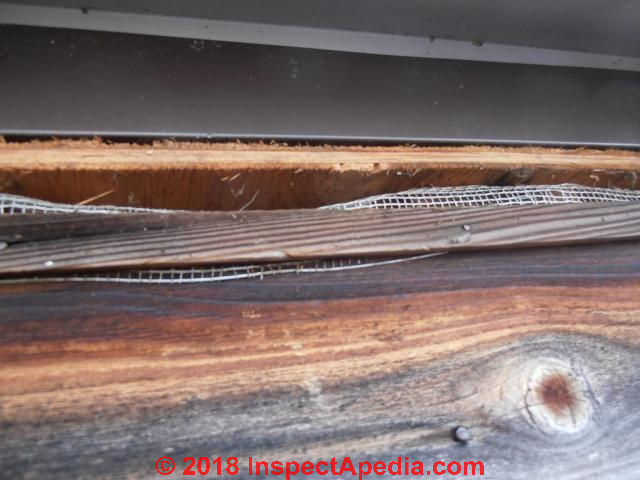 I have a 1976 Justus cedar home that has prow facades on both the 2nd and 3rd levels and a flatter gable in the back on the 3rd floor. The interior on the upper two floors is tongue and groove cedar cathedral ceilings.
I have a 1976 Justus cedar home that has prow facades on both the 2nd and 3rd levels and a flatter gable in the back on the 3rd floor. The interior on the upper two floors is tongue and groove cedar cathedral ceilings.
I replaced a shake style concrete tile roof with composition last summer because bats were getting under the tile roof.
Since then the roof began having loud popping and cracking noises during the summer particularly on warmer days here in the Pacific Northwest and they are frequent enough to seriously interfere with sleep.
During the re-roof it became clear that the roof was not unvented as I thought, but instead the prows and gable had about a 2-3 inch wire mesh strip over an opening between the sheathing and rigid foam insulation that had been pushed in by the animals for entry.
The roof is constructed like a hot roof with 2-3 in of rigid insulation and about a 3/4 in of air space between the furring strips and upper sheathing. This construction evidently met venting standards when the house was built.
The ridges have no ridge vents and there are no soffit vents.
I am thinking of adding Cobra ridge vents to allow for better ventilation but continuing to use the existing new metal mesh areas as the intake.
Does this seem like a reasonable approach?
I have read that the ratio of intake vs. outflow should be 50/50 or up to 60 % for intake if necessary.
I'm not sure how to calculate this accurately and would appreciate any suggestions you may have for addressing these issues. I will try to upload some pictures for clarification. - On 2019-01-23 by Redsail - >
This Q&A were posted originally
at CATHEDRAL CEILING INSULATION
Reply by (mod)
Wow - replacing an entire roof to keep out the bats sounds expensive and extreme.
Was that advice given to you by a professional pest control or animal control expert?
I'd have looked for specific entry points to be repaired and I might have added some separate bat -houses on the same property to encourage the bats, a useful and important species, to live peacefully nearby but out of the house.
Your photos show moisture stains that, if they're from inside the building, suggest that under-roof ventilation has not been adequate.
You might also want to look for and correct moisture sources indoors and air leaks into the ceiling from indoors.
Mesh type ridge vents do not pass as much air as the older, uglier, but in my opinion more-effective aluminum ridge vents.
And no ridge vent will help whatsoever (and may simply make matters worse) if there is not also adequate air intake at the building eaves or soffits as well as an air path up under the whole roof.Generally we want to be sure that there is more than a 50:50 ratio of intake to outlet venting area, otherwise you risk sucking conditioned air out of the occupied space, sending it out at the roof venting outlet.
See PROBLEMS with PARTIAL ROOF VENTILATIONOur primary question is: is your building design one using a "hot roof" that was designed to be insulated but not vented? Or is this design supposed to be vented?
More on this cathedral ceiling bat infestation is in a continuation of this reader Q&A found
Question: use of peppermint oil and ammonia to repel animal poopers and pests
I have heard that peppermint smell repels mice and squirrels. Is that so? - (Sept 23, 2012) Anonymous
Reply:
Good idea Anonymous. Peppermint is better than trying to scatter mothballs as using mothballs for animal repellant is an illegal application and can cause other building odor or health problems.
A number of animal repellant products do indeed contain peppermint oil, such as some deer and cat repellents. The mixtures for similar applications mix oils of peppermint, geranium, sage, lavender, eucalyptus, lemongrass etc.
There are other specific animal repellent sprays and products sold at home and garden suppliers, often targeted to specific animals: coyote urine, for example. I've also tried pouring a bit of ammonia (or bleach but never BOTH at once) onto an area on a walkway or stair where a cat kept urinating.
See REPELLENTS for ANIMAL PESTS
Outdoors where our neighbour's cat had decided that our stone walkway was a nicer toilet than its own yard we had such an accumulation of cat poop that besides cleaning up that mess we needed to encourage Cheeto to find a different relief site. After cleaning up the mess we poured household ammonia around the poop area.
That worked.
Question: Can I use peppermint oil to repel squirrels or other animals?
Photo above: Above-left: a Mexican praire dog (Cynomys mexicanus), a diurnal burrowing ground squirrel, and an agricultural pest in this cornfield, eyes the tourists, Guanajuato, Mexico (DF 2015).
Reader question: peppermint repels rodents?
I have heard that peppermint repels squirrels - is that true? - Anon 9/23/12
Photo above, a prarie dog in central Mexico peeps out of its burrow at the human intruders.
Reply:
You might indeed want to try peppermint oil Anon, as a number of animal repellant products do indeed contain peppermint oil, such as some deer and cat repellents.
There are mixtures for similar applications that mix oils of peppermint, geranium, sage, lavender, eucalyptus, lemongrass etc.
But our research into common preparations whose effectiveness has been tested as a squirrel repellant shows some different suggestions. I've included details just below.
Watch out: some folks use mothballs as an animal repellent. Using mothballs for animal repellant is an illegal pesticide application and can cause other building odor or even health problems.
See MOTHBALL ODORS
There are other specific animal repellent sprays and products sold at home and garden suppliers, often targeted to specific animals: coyote urine, for example.I've also tried pouring a bit of ammonia (or bleach but never BOTH at once) onto an area on a walkway or stair where a cat kept urinating.
...
Continue reading at GOPHER HOLE DAMAGE or select a topic from the closely-related articles below, or see the complete ARTICLE INDEX.
Or see
Recommended Articles
- ANIMAL ALLERGENS / PET DANDER
- ANIMAL DAMAGE to BUILDINGS - home
- ANIMAL ENTRY POINTS in BUILDINGS - home
- ANIMAL NOISES in BUILDINGS
- ANIMAL STAINS & MARKS in BUILDINGS
- ANIMAL or URINE ODOR REMOVAL
- ANIMAL or URINE ODOR SOURCE DETECTION
- BIRD DROPPING STAIN REMOVAL
- BIOLOGICAL POLLUTANTS
- BLACK STAINS from ANIMALS
- CARPET STAIN DIAGNOSIS
- CAT DANDER in BUILDINGS
- CRAWL SPACE CLEAN UP - clean up biological hazards from animals & rodents
- DOWNSPOUT DAMAGE from DOG CHEWING
- FIBER & HAIR IDENTIFICATION
- GOPHER HOLE DAMAGE
- GRAZING ANIMALS OVER SEPTIC SYSTEMS
- GROUNDHOG CONTROL
- MICE in BUILDINGS, GET RID OF
- OPOSSUM REMOVAL from BUILDINGS
- RACCOONS in the ATTIC
- SQUIRRELS in the HOUSE
Suggested citation for this web page
ANIMAL ENTRY POINTS in BUILDINGS at InspectApedia.com - online encyclopedia of building & environmental inspection, testing, diagnosis, repair, & problem prevention advice.
Or see this
INDEX to RELATED ARTICLES: ARTICLE INDEX to ANIMAL PESTS, ALLERGENS, HAZARDS
Or use the SEARCH BOX found below to Ask a Question or Search InspectApedia
Ask a Question or Search InspectApedia
Try the search box just below, or if you prefer, post a question or comment in the Comments box below and we will respond promptly.
Search the InspectApedia website
Note: appearance of your Comment below may be delayed: if your comment contains an image, photograph, web link, or text that looks to the software as if it might be a web link, your posting will appear after it has been approved by a moderator. Apologies for the delay.
Only one image can be added per comment but you can post as many comments, and therefore images, as you like.
You will not receive a notification when a response to your question has been posted.
Please bookmark this page to make it easy for you to check back for our response.
IF above you see "Comment Form is loading comments..." then COMMENT BOX - countable.ca / bawkbox.com IS NOT WORKING.
In any case you are welcome to send an email directly to us at InspectApedia.com at editor@inspectApedia.com
We'll reply to you directly. Please help us help you by noting, in your email, the URL of the InspectApedia page where you wanted to comment.
Citations & References
In addition to any citations in the article above, a full list is available on request.
- In addition to citations & references found in this article, see the research citations given at the end of the related articles found at our suggested
CONTINUE READING or RECOMMENDED ARTICLES.
- Carson, Dunlop & Associates Ltd., 120 Carlton Street Suite 407, Toronto ON M5A 4K2. Tel: (416) 964-9415 1-800-268-7070 Email: info@carsondunlop.com. Alan Carson is a past president of ASHI, the American Society of Home Inspectors.
Thanks to Alan Carson and Bob Dunlop, for permission for InspectAPedia to use text excerpts from The HOME REFERENCE BOOK - the Encyclopedia of Homes and to use illustrations from The ILLUSTRATED HOME .
Carson Dunlop Associates provides extensive home inspection education and report writing material. In gratitude we provide links to tsome Carson Dunlop Associates products and services.


